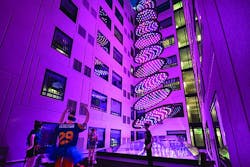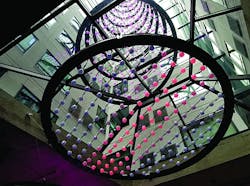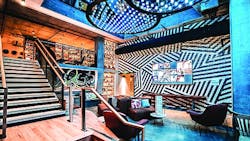Dynamic LED ceiling feature stuns in new Moxy San Diego hotel lobby (MAGAZINE)
Arrive as a guest at the new Marriott Moxy hotel in San Diego, CA and you will instantly know that it’s not your typical Marriott. Arrive late in the afternoon and you may find a DJ spinning tunes while guests lounge in communal spaces, perhaps play a classic game of video Pacman, and even create their own art on writing walls. And looming over the bar area in the center of the lobby, flowing to the back of the space, and rising through a glass ceiling into open space, a dynamic LED light-as-art feature enhances the guest experience. The solid-state lighting (SSL) feature is courtesy primarily of artistic consultancy Moment Factory and design studio Digital Ambiance.
Moxy San Diego has been open just a few months but is proving popular both with traveling guests and locals who frequent the Gaslamp Quarter. Moxy is a relatively new Marriott brand targeted at millennials and priced around the middle of Marriott’s diverse portfolio of different hotel concepts. The San Diego hotel is the first Moxy property in California.
The Moxy development project was driven by J Street Hospitality in San Diego, Delawie was the architect, and Swinerton built the eight-story hotel on a lot that was previously a surface parking lot. Azul Hospitality Group is managing the hotel operation.
Back to the guest experience, there is no registration desk. An arriving guest may be met by an employee on a tricycle-like cart where they can both mix the guest a custom arrival cocktail and register the guest. Or the check-in process can be completed at the bar.
The interior design concept is meant to be appealing, although the operational concept will enable a relatively lean operating budget as well. The 20-to-30-year-old target crowd will appreciate the fact that everything is a social space. Hotel employees, meanwhile, can multitask. There’s no conventional hotel restaurant. But there is a casual all-day menu available in the bar area along with grab-and-go food.
SSL feature
The developer and architect teams brought Moment Factory into the project development to create a “hero centerpiece fixture,” according to Andy Merkin, producer and office director for the Los Angeles, CA Moment Factory office. Merkin said the hotel was designed to “reimagine the hotel experience” and the SSL feature was an important part of that reimagination.
Moment Factory works on projects ranging from what they call “destination installations,” meaning permanent ones, to temporary installations for shows and events. The projects have ranged from high-resolution media such as video walls to lower-resolution yet dynamic projects such as the Moxy LED feature.
Standing in the rear of the hotel lobby, the architainment feature transitions from horizontal in nature and rises upward through the glass ceiling into an open space surrounded completely by the hotel structure. The outdoor portion of the SSL system had to be engineered to withstand a relatively harsh environment and is IP68 rated with the LED-based pucks integrating an encapsulated PCB, with 12 RGB LEDs in each puck. (Photo credit: Maury Wright.)
The LED installation consists of RGB (red, green, blue) LED-based pucks or pixels that are suspended on guy wires stretched across custom steel frames that are generally circular to oval in nature. Both Merkin and Robb Pope, CEO of Digital Ambiance, referred to the steel structures as leaves or as having a leaf-like look. But as you can see in the images, the leaves are relatively large compared to the typical plant leaf. Watch the video below to see an example of how the SSL system looks in action.
Project goals and obstacles
Moment Factory generally works on what Merkin calls congregational spaces. And he said the Moxy project was undertaken with the typical goal of creating “senses of awe and wonder when people are brought together in a space.” But the hotel project presented immediate challenges. The larger part of the installation would be above the glass roof in the rear of the lobby, surrounded by the hotel structure in a courtyard-like area, and exposed to the elements. Moreover, even without concerns relative to a harsh environment, there simply aren’t off-the-shelf SSL products to accomplish what Moment Factory had in mind.
Digital Ambiance, however, specializes in custom or bespoke systems that are conceived and manufactured specifically for a project such as the Moxy. Digital Ambiance could immediately counsel Moment Factory as to what might work and what would not in terms of reliable and affordable LED lighting systems with dynamic capabilities.
Pope and his team custom-designed the LED pucks that are essentially small plastic elements that deliver diffuse light. The clam-shell like pucks were based around an injection-molded housing. A small printed-circuit board (PCB) is installed in each puck. That PCB includes six RGB LEDs each on the top and bottom sides essentially delivering 360° of light. The pucks don’t use monochromatic red, green, and blue LEDs to provide the color mix. Pope’s team uses a multi-emitter LED from Cree with each packaged LED having RGB emitters. The team experimented and determined that 12 LEDs would afford the light levels they needed for the project.
The LED feature can paint the lobby in a chosen color or play dynamic shows such as a Happy Birthday celebration. The lobby does not resemble a traditional hotel lobby. All of the lobby space is intended for communal gatherings; guests can write messages on walls, there are classic video games such as PacMan, and there’s even a shipping container used for storage. (Photo credit: J Street Hospitality.)
The PCB design also includes a DC/DC converter to drive the 12 LEDs. The DC power comes via a simple three-wire cable assembly strung along the guy wires and connected in daisy chain fashion to a number of nodes. AC/DC LED drivers are hidden in the steel frame that forms each leaf and feed the DC power to the pucks.
That architecture sounds simple enough, but consider that the team still had to develop a connectivity scheme for controlling each puck, and the system had to work reliably outdoors. One approach to outdoor reliability would have been to design the molded housing to be waterproof. But Pope said such an approach would have been costly and hard to accomplish. Instead, the team used a conformal coating to encapsulate the PCB; thus, it doesn’t matter if moisture enters the puck housing. And of course the encapsulant materials used had to have relatively good optical properties. Pope said the design is IP68 rated. For more information on ingress protection ratings, see a prior feature article that discussed the ratings.
Connecting and controlling the nodes
For a connectivity scheme, Pope’s team sought to develop a system where each puck would have its own IP (Internet Protocol) address as is the case in Ethernet networks. Moreover, as is common in entertainment or architainment applications, Moment Factory wanted to use a DMX scheme to control the system.
Ultimately, Digital Ambiance used the Art-Net royalty-free protocol to transmit DMX commands in IP packets. The Art-Net protocol reached the pucks via the SPI (serial peripheral interface) that is a standardized serial communication scheme most often used for communications between digital ICs in products such as computers and consumer electronics. The SPI signals were connected using the same three-wire cable assembly that delivers the DC power to the pucks.
A PixLite DMX512 control system is the brains of the dynamic SSL feature. Moment Factory did the programming and created a catalog of what Merkin calls shows — essentially dynamic content meant to evoke a theme. The simplest shows might just use a static color as you can see in some of the photos presented here.
The complexity of the Moxy LED feature equated to a relatively long project-development timeline, although that timeline was impacted by the building of the hotel. But Pope said his team worked on the design of the SSL system for 18 months. Then the team had to get the system manufactured and installed in two months.
The shows
Back to the shows, when we visited the hotel during the middle of the day, the system was playing a simple repetitive color-changing loop. But Merkin said the full catalog includes shows that “try and build emotional connections” with people gathered in the space. He said the content, even in the case of the relatively low-pixel-resolution system, is intended to impact feelings, accentuate celebrations, and in general trigger an emotional response. For instance, there is a show he calls Burst Mode for Happy Birthday celebrations.
Guests that enter the Moxy won’t find a check-in counter, but may be met by an employee on the tricycle seen in the back right of the photo. That employee can handle the check-in procedure and mix the guest a welcome cocktail. Meanwhile, the bar marks the first leaf of the LED ceiling feature that continues through the lobby and up through the hotel space. (Photo credit: J Street Hospitality.)
One of the signature shows is meant to evoke a waterfall flowing through the lobby and ironically upward through the glass ceiling into the open area surrounded by guest rooms. Merkin said the animation utilizes planes of movement, a ripple effect, and varies the speed of movement in the same way water would flow at different rates in different parts of a stream or a waterfall.
For now, the Moxy LED feature is limited to the preprogrammed shows. Moment Factory is well known, however, for developing projects that take input from people or the surrounding environment to instantly conjure new shows. Merkin calls that technique “creative behavioral activity.” We have featured other projects that offer such capability including an architainment installation in the lobby of a Boston office building.
Data responsive
Moment Factory has such an iconic project in Montreal, Canada on the Jacques Cartier Bridge. The company describes that project as a data-responsive SSL installation. It creates shows based on traffic patterns and other activities in the city. One show uses a sensor to capture the spectral power distribution (SPD) of the sunset and replicates that on the bridge lighting.
Indeed, Merkin discussed such projects as a way to allow residents to visualize the smart-city movement. Cities are installing a variety of sensors that are meant for mission-critical applications such as traffic and pedestrian safety, but the data can be freely used elsewhere.
Merkin’s comments about smart cities were especially timely since we recently published a feature article on a San Diego smart city project where the city has installed cameras and other sensors throughout the Gaslamp Quarter and other parts of the city on street-light poles. In fact, there are multiple such smart-city nodes near the Moxy and San Diego has indicated a willingness to allow businesses in the city access to anonymized data.
Merkin said the Moxy management could still decide to add such data-responsive capability to its system. But he also cautioned that care is required. He said systems such as the aforementioned Boston office that take input from the public are inevitably impacted as mischievous people try and coerce some obscene or other inappropriate show. He said you have to always consider the potential of negative experiences for people.
For now, the Moxy system doesn’t even have a program that syncs to the music of the DJ mentioned at the top of this article. That fact was a conscious decision at this point, according to Merkin, because the system is easily capable of such a show. Even with music playing, disco is not the vibe of the congregational social space in the Moxy.

Maury Wright | Editor in Chief
Maury Wright is an electronics engineer turned technology journalist, who has focused specifically on the LED & Lighting industry for the past decade. Wright first wrote for LEDs Magazine as a contractor in 2010, and took over as Editor-in-Chief in 2012. He has broad experience in technology areas ranging from microprocessors to digital media to wireless networks that he gained over 30 years in the trade press. Wright has experience running global editorial operations, such as during his tenure as worldwide editorial director of EDN Magazine, and has been instrumental in launching publication websites going back to the earliest days of the Internet. Wright has won numerous industry awards, including multiple ASBPE national awards for B2B journalism excellence, and has received finalist recognition for LEDs Magazine in the FOLIO Eddie Awards. He received a BS in electrical engineering from Auburn University.








